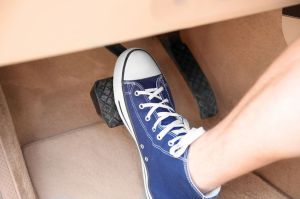There it was—an ad for dealing with imaginary learning loss. Nope—your kid doesn’t need remediation to bring him up to speed after this year of screen-based semi-school. He needs acceleration! Sure he’s, umm, fallen behind somebody, somewhere. But the solution is not reviewing what he may have missed—it’s accelerating. Going faster. Catching up, then presumably surging ahead. Winning.
I was so struck by the totally American nature of this language—We Must Compete! No remediation for us!—that I googled the company’s motto and found that there are several pre-packaged learning systems and books using the same theme and jargon.
Acceleration, it appears, is having (another) sexy moment. It may even be sexy enough to tap into some of that federal funding this summer, if education vendors hustle and enough media figures wring their hands while bemoaning ‘learning loss.’
If your kids have been moping around, griping about not seeing their friends and the head-banging monotony of Zoom lessons, it’s logical to be a little anxious about what they have not learned in the past year. Things that might have been not only interesting or challenging, but important for future coursework and plans. It’s OK to worry about their emotional health, their need for exercise and socializing.
But while I have absolute faith in well-prepared, caring teachers to do their best to move students forward, there are still a lot of balls in the air. Will enough people, old and young, be vaccinated in time for a new school year? What curve balls might the virus still be capable of? How will we re-evaluate most critical uses of instructional time with our overstuffed core curriculum—and how much permanent impact will a year of uncertainty and danger have on what ‘school’ looks like, this fall and all future school years?
Hard to say, but I am fairly certain that simply prescribing acceleration rather than remediation is an example of rhetorical flourish over substance.
My Masters degree is in Gifted Education. In my introductory courses, the foundational thinking in every article and text was that there were two basic streams of instructional practice designed to address the needs of gifted children—enrichment and acceleration. In short, going deeper or going faster. Or a combination of both.
The drawback of enrichment was that providing unique challenges for very bright kids meant you had to diversify learning, custom-tailoring lessons for differing ability, something that has always been available, but is a classroom management challenge. With acceleration, you could move children through existing structures faster—taking HS Algebra in 6th grade, for example. If you were willing to put your 11 year old in a class with high school freshmen, that is—and had a plan for what happened when her ability to the do the work outstripped her emotional maturity.
Working in the field of gifted education, it turned out that most parents didn’t care much about going deeper. What they wanted was not in-depth exploration but getting ahead of other students. Accelerating. The idea of extensive, hands-on digging into something Bright Child was passionately interested in was not appealing, especially if there were no tangible identifying markers of giftedness in the process.
I don’t remember much about elementary school, but I clearly remember my reading instruction in 5th grade. Instead of traditional reading groups, we were using brand-new SRA reading kits, color-coded 8 x 11 cards featuring stories or non-fiction articles. You moved up through the colors by passing little comprehension tests at the end of each card, until you reached aqua (or maybe it was gray). Then you started at the beginning of the next box.
You could accelerate by acing colors quickly. Miss a few questions, however, and you were stuck in purple for weeks. I remember scanning the room, or meeting someone at the box to exchange a card and noticing, hmmm—too bad, she’s on orange.
My teacher, Mrs. Wildfong, let me breeze through the first box. Then one day, instead of starting me on the 6th grade box, she pulled me into a corner of the room and showed me a small bookshelf. Quietly, she told me that for the rest of the year, I could read anything I liked on the lowest shelf. After I read the book, I was supposed to write a page in a small spiral-bound notebook about what I’d just read. There were no questions about POV, themes or characters—just my opinion, or what I’d learned.
I read every book on that shelf and filled several notebooks. After that, I had a permanent pass to the library, and permission to go during reading class whenever I needed new reading material. I read completely through the Beany Malone series, the Cherry Ames series, and a group of biographies with blue covers featuring black silhouettes. I also recall that other kids in the class wondered, with some resentment, why nobody else got to go to the library whenever they felt like it.
I remember the year, and Mrs. Wildfong, with great fondness. I tell this story not because I was ‘gifted’—I wasn’t—but because Mrs. Wildfong improvised enrichment, tailoring my reading curriculum without shorting her other students. For the rest of the day, I was doing long division and coloring maps with everyone else. Deeper, not faster.
In the 6th grade, I started at the beginning of the SRA box with everyone else, and when I started moving ‘too fast,’ my teacher made me stay for weeks in one color, reading all the yellow cards then all the brown cards, because heaven forbid any child should outstrip The SRA Box. I did not resent this—I really loved my 6th grade teacher—and my parents did not go to school to complain, to demand that a child reading at the 12th grade level be given special privileges, blah blah blah.
There are lessons in this completely ordinary story.
One is that the pandemic, for some children, may have been like my reading shelf and library pass—a chance to do something educational that they’re good at and enjoy, without the constraints of a large classroom full of kids who are good at and enjoy vastly different things, and a teacher trying to maintain order.
Another lesson is that some—again, just some—children will move forward on concepts or skills they normally would have encountered in the previous year very quickly, once they are given a bit of personal attention from a teacher who is not trying to teach 15 live children and 15 tiny, boxed heads on a screen simultaneously.
This is not about ‘acceleration’—it’s about a caring adult who has experience teaching this particular skill to children. We need teachers (and, importantly, school leaders) willing to dump pacing charts and incessant testing in favor of knowing their students–their personal goals and challenges, not their test scores. We need to reinforce skill- and knowledge-building, confidence and healing after a very rough year. There is no need to ‘set a high bar’—kids have always cleared learning bars at their own pace and feeling OK about yourself is a prerequisite.
A third lesson is that public education has increasingly become a consumer product, and advertising for that product now uses commercial language and advertising techniques. This doesn’t bode well, and probably lies under the insistence of many education nonprofits that standardized testing be done now, so the ‘data’ generated allows them to present a picture of deficient kids who need to go faster rather than deeper.
Let’s stop asking about learning loss and catching up. It’s not a race. Let’s provide the resources to move kids forward.


Oh, my! Mrs. Wildfong was a treasure. Imagine if every student had her in their past? I had to teach that dang SRA box. We all hated it!!
LikeLiked by 1 person
I only recall using SRA kits (as a reading program) for two years–in 1961-63. Before that, it was basals and reading groups. I suppose Mrs. Wildfong might have been labeled lazy or distracted today, because besides reading my little spiral-bound notebook, she basically let me fly free for a year. But I LOVED 5th grade, and looked forward to the 90 minutes every day when I got to just sit at my desk and read. I have no idea what ‘acceleration’ might have looked like–or how teachers today are going to ‘accelerate’ through ‘learning loss’ for a 5th grader who is already a strong and enthusiastic reader and writer. More pre-packaged curricular crapola, I’m sure.
LikeLike
“We need teachers (and, importantly, school leaders) willing to dump pacing charts and incessant testing in favor of knowing their students–their personal goals and challenges, not their test scores. ”
Yes!
LikeLiked by 1 person
It’s important to address “acceleration” as it has become a huge buzzword.
Cherry Ames. I read those too. She was quite a nurse but she sure changed jobs a lot. ( :
LikeLiked by 1 person
(laughing) Yup–from dude ranch to inner-city visiting nurse, rinsing out her nylon uniform in the sink at night.
I think the whole acceleration thing is a triumph of form over substance.
LikeLiked by 1 person
So much great in this, but why the parent bashing … “and my parents did not go to school to complain, to demand that a child reading at the 12th grade level be given special privileges, blah blah blah.” Gifted kids have rights and it isn’t “blah, blah” to address their needs. I have an autistic fully included so I 100% agree with you “improvising” teachers and enough teachers together is everything. I totally agree about pace, acceleration, competitive parenting, etc. Would you say parent concerns about his needs are blah, blah, too? Teachers are partners and part of a team with parents and admin. It’s important that work is approached with an open attitude and respect. Little disappointed if I am interpreting this meaning correctly.
LikeLike
Not parent bashing–just a reflection on the fact that parents have become vastly more vocal about what they think their children need and deserve. Some of that is good. Some of it is opportunity hoarding.
LikeLike
Yes, opportunity hoarding is surely a thing. Thanks for clarifying. 🙂
LikeLike
You prompted me to refresh my own SRA memories – we had the boxes in 7th grade, which I discovered today was spot on… the “inventor” came up with the idea (1950) while teaching 7th graders in a rural school, using scissors, paste and a tomato crate. Audrey Watters enlightened me: http://hackeducation.com/2015/03/19/sra
Thanks for continuing to write in public spaces and expanding our perspectives.
LikeLike
I linked to Audrey’s article somewhere in the blog. And seriously–the inventor of the kit was a genius, because he was custom-tailoring curriculum. Good on him, because he was demonstrating the golden rule of teaching: know your students. I think SRA kits made me suspicious of short, same-length articles and stories. Even today, I prefer long-form writing over the little generic 200-word nuggets of information.
The point remains: going faster, level by level, is seldom better than going deeper, relaxing into the beauty, intrigue or inherent problems in whatever you’re studying. Nice to hear from you again.
LikeLike
[…] Fry, used to show us movies from the Moody Bible Institute on Fridays, 100% creationist in nature. Mrs. Wildfong, fifth grade, let me skip the SRA kit and read whatever I liked from a shelf in her classroom. My HS physical education teacher, Mrs. […]
LikeLike